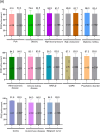A Large-Scale, Retrospective Analysis of Bath-Psoralen Plus Ultraviolet A Therapy for Psoriasis: A Single-Center Study
- PMID: 40804484
- PMCID: PMC12350823
- DOI: 10.1111/phpp.70038
A Large-Scale, Retrospective Analysis of Bath-Psoralen Plus Ultraviolet A Therapy for Psoriasis: A Single-Center Study
Abstract
Background/purpose: While biologics and small-molecule inhibitors are first-line systemic treatments for psoriasis, phototherapy remains an alternative for patients unable to access these treatments because of medical or financial constraints. Narrow-band ultraviolet B (NB-UVB) is effective for localized psoriasis but less so for extensive disease. To address this limitation, bathwater delivery of psoralen plus ultraviolet A (bath-PUVA) was introduced in 2004. This study evaluates the efficacy, safety, and patient characteristics associated with bath-PUVA therapy in a large cohort.
Methods: This retrospective analysis included 229 patients (180 males, 49 females) treated with bath-PUVA from 2004 to September 2021. Baseline characteristics and treatment outcomes were assessed using the psoriasis area and severity index (PASI). Statistical analyses examined relationships between treatment outcomes and factors, including baseline PASI, body mass index (BMI), and smoking status.
Results: The mean baseline PASI score was 24.9. Bath-PUVA achieved PASI 75 in 80.4% of patients, PASI 90 in 44.1%, and PASI 100 in 2.6%, with efficacy comparable to biologics. Patients achieving PASI 90 had significantly higher baseline PASI scores (p = 0.005), while the number of irradiations required did not differ (p = 0.692). Higher baseline PASI scores correlated with elevated BMI (p = 0.002), but BMI did not influence improvement rates (p = 0.094). Smokers had significantly higher baseline PASI scores (p = 0.004) compared with non-smokers, yet smoking status did not affect improvement rates (p = 0.862).
Conclusion: Bath-PUVA demonstrates efficacy comparable with biologics for psoriasis, regardless of BMI or smoking status. This analysis supports its use as an effective and accessible treatment option for patients with extensive disease.
Keywords: bath‐PUVA (bath‐psoralen plus ultraviolet a therapy); phototherapy; psoriasis.
© 2025 The Author(s). Photodermatology, Photoimmunology & Photomedicine published by John Wiley & Sons Ltd.
Conflict of interest statement
The authors declare no conflicts of interest.
Figures



References
MeSH terms
Substances
LinkOut - more resources
Full Text Sources
Medical

